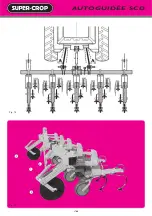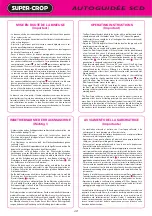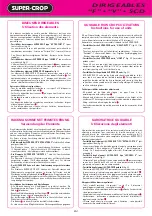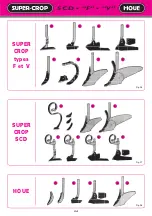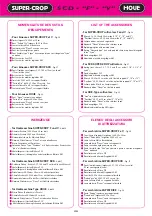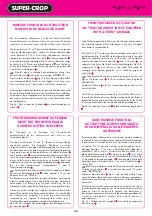
AUTOGUIDÉE SCD
17
MISE EN ROUTE DE LA BINEUSE
(Important)
• La bineuse, attelée au tracteur, béquille relevée, doit être utilisée poutre à
70 cm au dessus du sol.
• Les bras de relevage du tracteur doivent être flottants (chaînes détendues)
et de même longueur.
• Ajuster le 3
e
point pour que les éléments soient d’aplomb avec le sol,
bras de parallélogrammes horizontaux.
• Se présenter dans le champ parfaitement en ligne sur une des longueurs
de travail effectuées par le semoir.
• Poser la bineuse, relever les disques protège plants, avancer quelques
mètres puis vérifier si les réglages d’écartements des dents et disques
correspondent bien, si la profondeur de travail est bonne, si la pénétration
des coutres stabilisateurs est suffisante. Cette penetration dépend de la
compression du ressort 1 ; la manivelle 2 commande ce réglage : une
pénétration de 10 cm est suffisante en conditions normales.
• Avancer ensuite de nouveau d'une dizaine de mètres et vérifier cette fois
si la bineuse n'a pas dévié de la trajectoire imposée par le tracteur, Ceci
se contrôle au niveau des bras de relevage qui, bien que flottants, doivent
rester de chaque côté à égale distance des roues du tracteur (fig. ci-contre).
Si la bineuse a dévié, il faudra modifier légèrement l’orientation
des coutres stabilisateurs par le réglage 3 vers la droite si la bineuse
dévie à gauche et vers la gauche si la bineuse dévie à droite.
• Reprendre la conduite et vérifier de nouveau au bout de 10-20 m. Dès
qu’on a la certitude que la machine conserve la trajectoire du tracteur,
descendre les disques protège plants et parfaire l'enterrage des socs.
La bineuse sera alors prête, il faudra cependant savoir que, de par son
principe flottant, la machine ne déviera par la suite que difficilement de sa
trajectoire initiale. Il lui faudra une dizaine de mètres avant de répondre
aux sollicitations du tracteur. Le chauffeur devra donc en être conscient
lorsqu'il amorcera une courbe ou fera une erreur de conduite. Par contre,
les petits écarts du tracteur seront sans influence.
OPERATING INSTRUCTIONS
(Important)
• The Row Crop cultivator, hitched to the tractor, with its toolbar stand raised,
should be used with the toolbar frame 70 cm (28") above the ground.
• The tractor lift arms should be in a floating position (chains slackened)
and be of the same length.
• Adjust the TOPLINK length for the units to be level on the ground , with
parallelogram arms horizontal.
• On the field, line up exactly with marked line left while planting.
• Lower the Row Crop cultivator. Lift the cultivator shields, drive forward
a few feet and then check if all spacing adjustments of the tines and
discs are correct... if the working depth is good, if the penetration of the
stabilizing coulters is sufficient. This penetration depends on the spring
compression 1 ; this adjustment is controlled by the crank 2 ; 10 cm (4")
penetration is adequate under normal conditions.
• Drive forward again about 10 meters (30’) and check if the Row Crop
cultivator has not moved from its position to the tractor. This is
accomplished by the lift arms. Although in a floating position, they
should remain on either side at equal distance from the tractor wheels
(fig. opposite).
If the Row Crop cultivator has moved, the setting of the stabilizing
coulters should be slightly modified by the adjusting device 3 to the
right if the Row Crop cultivator moves to the left and to the left if the
Row Crop cultivator moves to the right.
• Drive again 10 to 20 m (30’-60’) and check. As soon as you are sure that
the Row Crop cultivator follows straight behind the tractor, lower the
rotating cultivator shields and make a last check about penetration and
working depth.
The Row Crop cultivator is now ready to start. However it should be
pointed out that due to its floating principle, the machine will not easily
move from its initial direction. It will require about ten meters (30’) before
responding to the direction of the tractor. The driver should therefore be
aware of this fact when taking a curve or if making a driving mistake. On
the contrary, small deviations of the tractor will have no influence.
INBETRIEBNAHME DER HACKMASCHINE
(Wichtig !)
• Hackmaschine an den Schlepper anbauen Abstellstütze hochstellen - die
Rahmenhöhe beträgt 70 cm.
• Die Unterlenkerarretierungen sind nicht festzustellen, damit die
Maschine hinter dem Schlepper frei nach links und rechts pendeln kann
(mit entspannten Ketten).
• Den Oberlenker so einstellen, daß der Oberlenkeranbaubock genau
senkrecht steht.
• Fahren Sie mit den Schlepperrädern in die richtige Reihe und achten Sie
dabei auf den richtigen Abstand zu den Pflanzenreihen.
• Hackmaschine auf den Boden stellen, die Pflanzenschutzscheiben
hochhängen, ein paar Meter fahren, dann prüfen, ob die Einstellung von
Zinken- und Scheibenabständen richtig sind, ob die Arbeitstiefe stimmt
und ob das Scheibensech genügend in den Boden eindringt. Das
Eindringen in den Boden richtet sich nach dem Druck der Feder 1 . Mit
der Kulber kann die Tiefe verstellt werden.
• Fahren Sie dann noch ein paar Meter weiter und prüfen Sie, ob die
Hackmaschine nach links oder rechts in eine Pflanzenreihe gelaufen ist.
Auf jeden Fall sollen die Unterlenkerarme den gleichen Abstand zu den
Hinterrädern haben.
• Sollte die Hackmascine nach links oder rechts gelaufen sein, so muß die
Richtung der Scheibenseche verstellt werden. Dies ist durch die
Einstelschraube 3 möglich.
• Fahren Sie jetzt weiter und kontrollieren Sie die Maschine wieder nach ca.
20 m. Sobald Sie sicher sind, daß die Hackmaschine der Richtung des
Schleppers folgt, stellen Sie die Pflanzenschutzcheiben herab und die
Tiefenregulierung der Schare ein.
Die Hackmaschine ist jetzt einsatzbereit. Durch die beiden Scheibensechs
wird die Maschine so stabilisiert, daß die Maschine in ihrer Anfangsrich-
tung schwer geändert wird. Sie braucht noch ungefähr 10 m bis sie der
Bewegung des Schleppers folgen kann. Der Fahrer muß die Bewegung
der Maschine kennen, wenn er eine Kurve fährt. Kleine Richtungsände-
rungen haben keine Einwirkung auf die Richtung der Hackmaschine.
AVVIAMENTO DELLA SARCHIATRICE
(Importante)
• La sarchiatrice attaccata al trattore, con il sostegno sollevato, é da
utilizzare con la trave posizionata a 70cm dal suolo.
• I bracci di sollevamento del trattore devono avere un movimento libero
(catene stese) e di lunghezza uguale.
• Aggiustare il terzo punto affinché gli elementi siano perpendicolari al
suolo, con i bracci di parallelogrammi orizzontali.
• Presentarsi nel campo perfettamente in linea su una delle lunghezze di
lavoro effettuate dalla seminatrice.
• Posare la sarchiatrice, sollevare i dischi proteggi-piante, avanzare alcuni
metri poi verificare che gli aggiustamenti di intervalli dei denti e dischi
corrispondano correttamente, che la profondità di lavoro sia buona, che la
penetrazione dei coltri stabilizzatori sia sufficiente. Questo interramento
dipende dalla compressione della molla 1 ; la manovella comanda questa
regolazione : una penetrazione di 10 cm é sufficiente nelle condizioni normali.
• Poi movere ancora la sarchiatrice circa dieci metri e controllare allora
che la macchina non abbia deviato dalla traiettoria imposta dal trattore.
Questo si controlla al livello dei bracci elevatori che, benché siano mobili,
devono rimanere ad ogni lato a iguale distanza dalle ruote del trattore (fig.
qui accanto).
Qualora la sarchiatrice avesse deviato, occorrerà modificare leggermente
l'orientazione dei coltri stabilizzatori tramite la regolazione 3 a destra se
la macchina devia a sinestra e a sinestra se la macchina devia a destra.
• Riprendere la guida e verificare di nuovo dopo 10-20m. Appena Lei é
certo che la macchina mantiene la traiettoria del trattoria, abbassi i dischi
proteggi-piante e aggiusti l'interramento dei vomeri.
La sarchiatrice é allora pronta. Tuttavia occorre sapere che a causa del suo
principio di movimento libero, la macchina devierà posteriormente con
difficoltà dalla traiettoria iniziale. Bisognerà ca. dieci metri prima di
rispondere alle sollecitazioni del trattore. Quindi il conduttore dovrà
averne coscienza quando comincierà una curva o farà un errore di guida.
Invece i piccoli scarti del trattore non avranno nessuna influenza sulla
direzione della macchina.
Summary of Contents for SUPER-CROP C1L
Page 14: ...12 AUTOGUID E SCD Fig 1 Fig 2 Fig 4 Fig 3 Fig 5 F D C C B E...
Page 16: ...AUTOGUID E SCD 14 Fig 8 Fig 6 Fig 10 Fig 9 Fig 12 Fig 11 8 1 3 6 7 7 9 2 4 5...
Page 18: ...AUTOGUID E SCD 16 Fig 13 Fig 14 3 2 1 3...
Page 46: ...44 SCD BINEUSE AUTODIRIG E SCH MA LECTRIQUE Fig 94 Fig 97 Fig 96 Fig 95 Fig 98 2 1...














